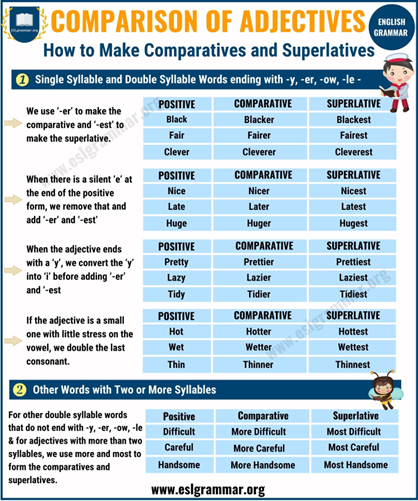Key Takeaways
- A comparative adjective compares two people or things (i.e. John is taller than Jack.)
- A superlative adjective compares the extremes of three or more things. (i.e. John is the tallest boy in the class.)
- To correctly use these forms, add -er for shorter comparative adjectives and -est for shorter superlative adjectives; while using more in front of longer comparatives and most in front of longer superlatives.
In the English language, adjectives are what we use to describe or identify a noun or pronoun. For example, fluffy might describe a dog or chair, while red could identify a car or apple. Comparative and superlative adjectives are what we use to make comparisons and show extremes. Mastering these forms can help you communicate more clearly and strengthen your writing and speaking skills. Let’s dive into how to use comparative and superlative adjectives:
What Are Comparative Adjectives?
Comparative adjectives compare two or more things or describe a difference. To form a sentence using a comparative adjective, follow this structure:
Formula: Noun (subject) + verb + comparative adjective + than + noun (object).
Example: Jack + runs + faster + than + his brother.
Here are other example sentences:
- My hair is shorter than Claire’s.
- Sarah’s car is more expensive than Lisa’s.
- Is this suit available in a larger size?
What Are Superlative Adjectives?
Superlative adjectives compare things as being the highest or lowest degree of the adjective. We use the with superlative adjectives. To form a sentence using a superlative adjective, follow this structure:
Formula: Noun (subject) + verb + the + superlative adjective + noun (object).
Example: I + ate + the + most delicious + pizza.
Here are other example sentences:
- Max is the fastest runner in the class.
- Jack is the most intelligent person I have ever met.
- Lilly is the youngest girl in her family.
The Basic Rules for Creating Comparative and Superlative Adjectives
When changing an adjective into its comparative or superlative form, the change you make will be dependent on the syllables. Follow these guidelines so you can use them correctly:
Rule #1: One Syllable
If the adjective has one syllable (i.e. large, or old), add -er to the end of it to form the comparative. For example: Fast → Faster.
To form the superlative of a one-syllable adjective, add -est to the end of the adjective. For example: Fast → Fastest.
Note: if the adjective ends in -e (i.e. wise or late), just add the -r or -st to the end. For example: Wise → Wiser (comparative) → Wisest (superlative).
Examples:
| One-Syllable Adjective | Comparative | Superlative |
| Short | Shorter | Shortest |
| Old | Older | Oldest |
| Large | Larger | Largest |
| Cold | Colder | Coldest |
Comparative Sentence Example: The blue shirt is cheaper than the red one.
Superlative Sentence Example: I am looking for the cheapest couch options.
Note: For comparative adjectives, you can use modifiers like “very” and “extremely” to add emphasis or intensity to the comparison. In this case, the modifier would be added and the adjective would stay the same. For example:
- “Her car is very fast compared to mine.”
- “This book is extremely interesting compared to the last one.”
Rule #2: One-Syllable Consonant
If the adjective has a single vowel between two consonants (i.e. hot) then the second consonant will be doubled for both types. For example: Hot → Hotter → Hottest.
Examples:
| One-Syllable Consonant Adjective | Comparative | Superlative |
| Big | Bigger | Biggest |
| Mad | Madder | Maddest |
| Dim | Dimmer | Dimmest |
| Fat | Fatter | Fattest |
| Sad | Sadder | Saddest |
Comparative Sentence Example: The ground is wetter after the second rainstorm.
Superlative Sentence Example: Out of all the towels, this one is the wettest from the spill.
Rule #3: Two Syllables Ending in Y
If the adjective you are using ends in -y (i.e. lucky or pretty), then you will drop the -y and add -ier for the comparative form and -iest for the superlative form.
Examples:
| Two-Syllable Adjective | Comparative | Superlative |
| Lucky | Luckier | Luckiest |
| Pretty | Prettier | Prettiest |
| Happy | Happier | Happiest |
Comparative Sentence Example: This puzzle is easier than the last one.
Superlative Sentence Example: This is the easiest puzzle I’ve ever done.
Rule #4: Two or More Syllables
For adjectives with two or more syllables, you often use more for comparatives and most for superlatives. For example, interesting would become more interesting or most interesting.
Examples:
| Two or More Syllable Adjectives | Comparative | Superlative |
| Expensive | More Expensive | Most Expensive |
| Important | More Important | Most Important |
| Intelligent | More Intelligent | Most Intelligent |
Comparative Sentence Example: This jacket is more expensive than the other one.
Superlative Sentence Example: This is the most expensive jacket in the store.
Rule #5: Special Adjectives
In some cases, there are adjectives that can use either -er/-est or more/most to form their comparative or superlative forms.
Examples:
| Special Adjective | Comparative | Superlative |
| Clever | Cleverer/More Clever | Cleverest/Most Clever |
| Quiet | Quieter/More Quiet | Quietest/Most Quiet |
| Brave | Braver/More Brave | Bravest/Most Brave |
| Sure | Surer/More Sure | Surest/Most Sure |
Comparative Sentence Example: He is cleverer than her. or He is more clever than her.
Superlative Sentence Example: She is the quietest student. or She is the most quiet student.
The Exceptions to the Rules: Irregular Adjectives
Some adjectives don’t follow the standard rules of -er/-est or more/most and are therefore called irregular adjectives. For example: Good → Better than → the Best.
Examples:
| Irregular Adjective | Comparative | Superlative |
| Bad | Worse | Worst |
| Little | Less | Least |
| Far | Farther | Farthest |
Incorrect Comparative Sentence Example: This movie is badder than the one from last week.
Correct Comparative Sentence Example: This movie is worse than the one from last week.
Incorrect Superlative Sentence Example: He has the littlest amount of money.
Correct Superlative Sentence Example: He has the least amount of money.
Here’s a Cheat Sheet to Help You Remember the Rules:

Sourced from ESL Grammar
Tips for Avoiding Common Mistakes
Whether you’re writing or speaking, remember these quick tips to avoid common mistakes:
- Use -er and -est for short adjectives (e.g., big → bigger, fast → fastest).
- For longer adjectives, use more and most (e.g., more comfortable, most interesting).
- Be careful with irregular adjectives. For example, bad doesn’t become badder, but instead becomes worse.
- If you’re unsure which form to use, say the sentence out loud to hear if it sounds natural or awkward.
- Don’t use both more and -er at the same time. For example, it’s wrong to say “more taller.” Instead, just say taller.
Mastering Comparatives and Superlatives
Knowing exactly how to use comparative and superlative adjectives can greatly improve your communication skills. Just remember, an adjective describes a noun, a comparative adjective compares the differences, and a superlative adjective shows the extremes when comparing three or more things. When you master these forms, it will make a noticeable difference in your writing and speaking.
Looking for the best college for you? Use College Raptor’s College Match tool and get college matches based on GPA, majors, location, test scores, and campus culture.






